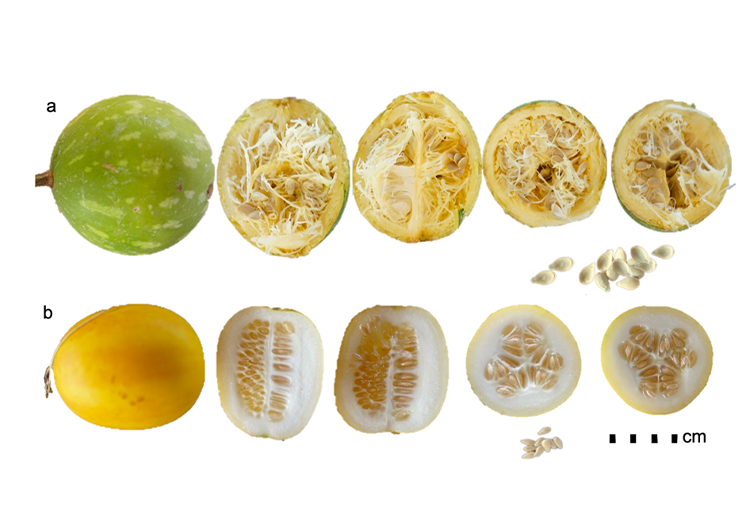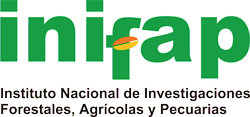Biometrics in fruits and seeds of two species of wild cucurbits from the Mexican tropics
DOI:
https://doi.org/10.29312/remexca.v16i2.3553Keywords:
Cucumis, Cucurbita, characterization, morphologyAbstract
The objective was to evaluate the morphometry of fruits and seeds in two species of wild cucurbits, orange melon Cucumis melo var. chito (C. Morren) Naudin and chicayota Cucurbita argyrosperma subsp. sororia, in 2020. Three replications of 100 fruits of each species were randomly taken. The weight, length, shape and color of fruits, seeds and embryo, and the number of seeds were recorded. Data were analyzed using central tendency measures with the SAS program. Both species have small fruits and seeds. Chicayota has fibrous flesh, yellowish white in color, and seeds with edges. The fruits of orange melons are oval, with smooth skin, yellow in color, with orange-yellow longitudinal lines and white flesh. The seeds of the two species are pyriform, yellow, with an embryo. They are little-studied species, with characteristics similar to those of their genus and can be given greater agronomic use.
Downloads
References
Balvino-Olvera, F. J.; Sánchez-Gómez, K. F.; Lobo, J. A.; Ávila-Sakar, G.; Cruz-Reyes, R.; Sánchez-Montoya, G.; Herrerías-Diego. Y.; González-Rodríguez, A. and Quesada, M. 2017. Latitudinal structured populations of the Mexican wild squash Cucurbita argyrosperma subsp. sororia revealed by microsatellite markers. Crop and Pasture Science. 68(9):850-858. https://doi.org/10.1071/CP17341.
Bautista, J. M.; Barragan, R. I.: Martínez, S. G.; Camarena, A. E.: Barboza-Corona, J. E. y León, G. F. 2016. Caracterización físico química de la semilla de chicayota (Cucurbita argyrosperma sororia). Investigación y Desarrollo en Ciencia y Tecnología. 1(1):378-382.
Bisognin, D. A. 2002. Origin and evolution of cultivated cucurbits. Ciência Rural. 32(4):715-723. https://doi.org/10.1590/S0103- 84782002000400028.
Canul-Ku, J.; Ramírez-Vallejo, P.; Castillo-González, R. y Chávez-Servia, J. L. 2005. Diversidad morfológica de calabaza cultivada en el centro-oriente de Yucatán, México. Revista Fitotecnia Mexicana. 28(4):339-349. https://www.redalyc.org/pdf/610/61028406.pdf.
Castellanos-Morales, G.; Ruiz-Mondragón, K. Y.; Hernández-Rosales, H. S.; Sánchez-de la Vega, G.; Gámez, N.; Aguirre-Planter, E.; Montes-Hernández, S.; Lira-Saade, R. and Eguiarte, L. E. 2019. Tracing back the origin of pumpkins (Cucurbita pepo ssp. pepo L.) in México. The Royal Society. 286(1908):1-9. https://doi.org/10.1098/rspb.2019.1440.
Chí-Sánchez, F. A.; Alvarado-López, C. J.; Cristobal-Alejo, J. y Reyes-Ramírez, A. 2020. Características morfológicas y determinación de minerales por -XRF en fruto de calabaza (Cucurbita moschata DUCH). Agrociencia. 54(5):683-690. Doi.org/10.47163/agrociencia.v54i5.2125.
CONABIO. 2006. Comisión Nacional para la Biodiversidad. Sistema de Información de Organismos vivos Modificados. Proyecto GEF-CIBIOGEM de Bioseguridad. 1-28 pp. http://www.conabio.gob.mx/conocimiento/bioseguridad/doctos/consulta-SIOVM.html.
Cos, P.; Maes, L.; Vlietinck, A. and Pieters, L. 2008. Plant derived leading compounds for chemotherapy of human immunodeficiency virus (HIV) infection and update (1998-2007). Planta Medica. 74(11):1323-1337. Doi: 10.1055/s-2008-1081314.
Delgado-Paredes, G. E.; Rojas-Idrogo, C.; Sencie-Tarazona, A. y Vásquez-Núñez, L. 2014. Caracterización de frutos y semillas de algunas cucurbitáceas en el norte del Perú. Revista Fitotecnia Mexicana. 37(1):7-20. http://www.scielo.org.mx/pdf/rfm/v37n1/v37n1a4.pdf.
Eguiarte, L. E.; Equihua-Zamora, C. y Espinosa-Asuar, L. 2017. La milpa es un espejo de la diversidad biológica y cultural de México. Oikos. 17:7-9. http://web.ecologia.unam.mx/oikos3.0/index.php/todoslosnumeros/articulosanteriores/210-milpaespejo-de-la-diversidad.
Eguiarte, L. E.; Hernández-Rosales, H. S.; Barrera-Redondo, J.; Castellanos-Morales, G.; Paredes-Torres, L. M.; Sánchez-Vega, G.; Ruiz-Mondragón, K. Y.; Vázquez-Lobo, A.; Montes-Hernández, S.; Aguirre-Planter, E.; Souza, V. y Lira, R. 2018. Domesticación, diversidad y recursos genéticos y genómicos de México: el caso de las calabazas. Revista Especializada en Ciencias Químico-Biológicas. 21(2):85-101. https://doi.org/10.22201/fesz.23958723e.2018.0.159.
Espitia-Camacho, M. M.; Araméndiz-Tatis, H. y Cardona-Ayala, C. E. 2021. Correlaciones y análisis de sendero en características del fruto y la semilla de Benincasa hispida [(Thunb.) Cong.]. Revista Temas Agrarios. 26(1):1-10. https://doi.org/10.21897/rta.v26i1.2557.
Fernández, I. S. 2020. Evaluación del efecto de patrones experimentales sobre la calidad de variedades tradicionales de melón (Cucumis melo L.). Trabajo final de grado de Ingeniería agronómica y del medio natural. Universidad Politécnica de Valencia. 39 p. https://m.riunet.upv.es.
Guerrero, G. E. 2020. Enciclopedia del estado de Guerrero. http://siglo.inafed.gob.mx/enciclopedia/ EMM12guerrero/municipios/12023a.htm.
Gupta, P.; Chikkala, S. and Kundu, P. 2019. Ash gourd and its applications in the food, pharmacological and biomedical industries. International Journal of Vegetable Science. 27(1):44-53. https://doi.org/10.1080/19315260.2019.1699222.
Hufford, M. B.; Martínez-Meyer, E.; Gaut, B. S.; Eguiarte, L. E. and Tenaillon, M. I. 2012. Inferences from the historical distribution of wild and domesticated maize provide ecological and evolutionary insight. Plos One. 7(11):47659-47667. Doi. org/10.1371/journal.pone.0047659.
Ibrahim, S.; Haidari, R. A.; Mohamed, G.; Elkhayat, E. and Moustafa, M. 2016. Cucumol A: a cytotoxic triterpenoid from Cucumis melo seeds. Revista Brasileira de Farmacognosia. 26(6):701-704. https://doi.org/10.1016/j.bjp.2016.03.012.
Jarret, R. L.; Levy, I.; Potter, T. L.; Cermak, S. C. and Merrick, L. C. 2013. Seed oil content and fatty acid composition in a genebank collection of Cucurbita moschata Duchense and C. argyrosperma C. Heber. Plant Genetic Resources: Characterization and Utilization. 11(2):149-157. Doi: 10.1017/S1479262112000512.
Kader, A. 2002. Postharvest technology of horticultural crops. Ed. Third Ed. University of California. Agriculture and Natural Resources Publication 3311. CA, USA. 535 p.
Kerje, T. and Grum, M. 2000. The origin of the melon, Cucumis melo: a review of the literature. Acta Horticulturae. 510(510):37-44. https://doi.org/10.17660/ActaHortic.2000.510.5.
Laínez, D. y Krarup, C. 2008. Caracterización en pre y poscosecha de dos cultivares de melón reticulado del tipo Oriental (Cucumis melo Grupo Cantalupensis). Ciencia e Investigación Agraria. 35(1):59-66. http://dx.doi.org/10.4067/S0718-16202008000100006.
Lemus, I. Y. y Hernández, S. J. C. 2003. Situación actual del mejoramiento genético del melón para su resistencia al mildiu pulverulento de las cucurbitáceas. Temas de Ciencia y Tecnología. 7(19):25-36.
Lira, R.; Eguiarte, L. E. y Montes-Hernández, S. 2009. Proyecto Recopilación y análisis de la información existente de las especies de los géneros Cucurbita y Sechium que crecen y/o se cultivan en México. Comisión Nacional de la Biodiversidad (CONABIO). México, DF. 107 p.
Lira, R.; Eguiarte, L.; Montes, S.; Zizumbo-Villarreal, D.; Marín, P. C. G. and Quesada, M. 2016. Homo sapiens-Cucurbita interaction in Mesoamerica: domestication, dissemination, and diversification. In: Lira, R.; Casas, A. and Blancas, J. Ed. Ethnobotany of Mexico. Ethnobiology. New York: Springer. 389-401. Doi. org/10.1007/978-1-4614-6669-7-15.
Lozada-Aranda, M.; Rojas-Barrera, I.; Mastretta-Yanes, A.; Ponce-Mendoza, A.; Burgeff, C.; Orjuela, R. M. A. y Oliveros, O. 2017. Las milpas de México. Oikos. 17:10-12. http://goo.gl/fsFQxq.
Melo, M. L. S.; Narain, N. and Bora, P. S. 2000. Characterization of some nutritional constituents of melon (Cucumis melo Hybrid AF-522) seeds. Food Chemistry. 68(4):411-414. https://doi.org/10.1016/S0308-8146(99)00209-5.
Montes, R. C.; Vallejo, C. F. A. y Baena, G. D. 2004. Diversidad genética de germoplasma colombiano de zapallo (Cucurbita moschata Duchesne ex Poir). Acta Agronómica. 53(3):43-50. https://repositorio.unal.edu.co/handle/unal/22023.
Moreno-Letelier, A.; Liguori, J. A.; Tenaillon, M. I.; Piñero, D.; Gaut, B. S.; Lobo, A. V. and Eguiarte, L. E. 2018. Was maize domesticated in the Balsas Basin? Complex patterns of genetic divergence, gene flow and ancestral introgressions among Zea subspecies suggest an alternative scenario. 239-707 pp. Doi.org/10.1101/239707.
Moscatero, J.; Mejía, F. y Gamarra, O. 2002. Taxonomía de las Fanerógamas útiles del Perú. Consejo Nacional de Ciencia y Tecnología (CONCYTEC). Trujillo, Perú. 667-669 pp. http://biblioteca.cultura.pe:8020/cgi-bin/koha/opac-detail.pl?biblionumber=2628.
Munger, H. M. and Robinson, R. W. 1991. Nomenclature of Cucumis melo L. Cucurbit genetics cooperative report. 14(45):43-44. https://cucurbit.info/1991/07/nomenclature-of-cucumis-melo-l/.
Naudin, C. 1859. Essais d’une monographie des espèces et desvariétés du genre Cucumis. Ann. Sci. Nat. 11:5-87. https://search.worldcat.org/es/title/Essais-d'une-monographie-des-especes-et-des-varietes-du-genre-cucumis/oclc/493999746.
Obando, J.; Fernandez-Trujillo, J. P.; Martinez, J. A.; Alarcón, A. L.; Pere, A. I. A. and Monforte, A. J. 2008. Identification of melon fruit quality quantitative trait loci using near-isogenic lines. Journal American Society for Horticultural Science. 133(1):139-151. https://doi.org/10.21273/JASHS.133.1.139
Ordoñez, N. G. A.; Ortiz, G. S.; Valdez, R. M. P. y Vallejo, C. F. A. 2014. Selección de introducciones de Cucurbita por contenido de aceite en semillas. Acta Agronómica. 63(2):1-10. Doi.org/10.15446/acag.v63n2.40026.
Paris, M. K.; Zalapa, J. E.; McCreight, J. D. and Staub, J. E. 2008. Genetic dissection of fruit quality components in melon (Cucumis melo L.) using a RIL population derived from exotic 9 elite US Western Shipping germplasm. Mol Breed 22(3):405-419. Doi: 10.1007/s11032-008-9185-3.
Pitrat, M. 2013. Phenotypic diversity in wild and cultivated melons (Cucumis melo). Plant biotechnology, advanced publication by J-STAGE. 1-6 pp. https://doi.org/10.5511/plantbiotechnology.13.0813a.
Pradhan, K.; Nandi, A.; Das, S.; Sahu, G. S.; Sarkar, S. and Patnaik, A. 2018. Genetic variability and varietal performance in Ash Gourd [Benincasa hispida (Thunb) Cogn.] genotypes. The Bioscan. 13(1):791-794. https://www.researchgate.net/publication/333446111-genetic-variability-and-varietal-performance-in-ash-gourd-benincasa-hispida-thunb-cogn-genotypes.
Ramamurthy, R. K. and Waters, B. M. 2015. Identification of fruit quality and morphology QTLs in melon (Cucumis melo) using a population derived from flexuous and cantalupensis botanical groups. Euphytica. 204:163-177. Doi:10.1007/s10681-015-1361-z.
Sánchez-Vega, G.; Castellanos-Morales, G.; Gámez, N.; Hernández-Rosales, H. S.; Vázquez-Lobo, A.; Aguirre-Planter, E.; Montes-Hernández. S.; Lira, R. and Eguiarte, L. E. 2018. Genetic resources in the “calabaza pipiana” pumpkin (Cucurbita argyrosperma) in Mexico: genetic diversity, genetic differentiation and distribution models. Frontiers in Plant Science. 9(400):1-18. http://doi.org/10.3389/fpls.2018.00400.
Sanjur, O. I.; Piperno, D. R.; Andres, T. C. and Wessel-Beaver, L. 2002. Phylogenetic relationships among domesticated and wild species of Cucurbita (Cucurbitaceae) inferred from a mitochondrial gene: implications for crop plant evolution and areas of origin. Proc Nati Acad Sci USA. 99(1):535-540. Doi: 10.1073/pnas.012577299.
SAS Institute. 2011. SAS/STAT® 9.3 User’s Guide. SAS Institute. Cary, North Carolina. USA. 8621 p.
Shellie, K. C. and Lester, G. 2006. Netted melons. In: Gross, K. C.; Wang, C. Y. and Salveit, M. Eds. The commercial storage of fruits, vegetables and florist and nursery stocks. USDA Agricultural Handbook. 66 p.
Tingle, C. H. and Chandler, J. M. 2003. Influence of environmental factors on smell melon (Cucumis melo var. dudaim Naud.) germination, emergence and vegetative growth. Weed Science. 51(1):56-59. https://doi.org/10.1614/0043-1745(2003)051[0056:IOEFOS]2.0.CO2.
Tingle, C. H.; Steele, G. L. and Chandler, J. M. 2003. Competition and control of smellmelon (Cucumis melo var. dudaim Naud.) in cotton. Weed Science. 51(4):586-591. https://doi.org/10.1614/0043-1745(2003)051[0586:CACOSC]2.0.CO;2.
Valdés, M. P. 2013. Estudio de la variabilidad y acción génica del carácter extracto etéreo y sus componentes en semillas de Cucurbita moschata Duch. y Cucurbita argyrosperma subesp. sororia. Tesis Doctoral Universidad Nacional de Colombia sede Palmira. Palmira, Valle, Colombia. 150 p.

Published
How to Cite
Issue
Section
License
Copyright (c) 2025 Revista Mexicana de Ciencias Agrícolas

This work is licensed under a Creative Commons Attribution-NonCommercial 4.0 International License.
The authors who publish in Revista Mexicana de Ciencias Agrícolas accept the following conditions:
In accordance with copyright laws, Revista Mexicana de Ciencias Agrícolas recognizes and respects the authors’ moral right and ownership of property rights which will be transferred to the journal for dissemination in open access. Invariably, all the authors have to sign a letter of transfer of property rights and of originality of the article to Instituto Nacional de Investigaciones Forestales, Agrícolas y Pecuarias (INIFAP) [National Institute of Forestry, Agricultural and Livestock Research]. The author(s) must pay a fee for the reception of articles before proceeding to editorial review.
All the texts published by Revista Mexicana de Ciencias Agrícolas —with no exception— are distributed under a Creative Commons License Attribution-NonCommercial 4.0 International (CC BY-NC 4.0), which allows third parties to use the publication as long as the work’s authorship and its first publication in this journal are mentioned.
The author(s) can enter into independent and additional contractual agreements for the nonexclusive distribution of the version of the article published in Revista Mexicana de Ciencias Agrícolas (for example include it into an institutional repository or publish it in a book) as long as it is clearly and explicitly indicated that the work was published for the first time in Revista Mexicana de Ciencias Agrícolas.
For all the above, the authors shall send the Letter-transfer of Property Rights for the first publication duly filled in and signed by the author(s). This form must be sent as a PDF file to: revista_atm@yahoo.com.mx; cienciasagricola@inifap.gob.mx; remexca2017@gmail.
This work is licensed under a Creative Commons Attribution-Noncommercial 4.0 International license.


